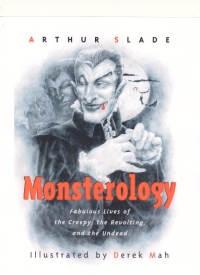| ________________
CM . . .
. Volume XII Number 4 . . . .October 14, 2005
excerpt:
Monsterology is an unusual, imaginative "biography" of 15 creatures from mythology (Medusa, Loki), literature (Frankenstein's monster, Quasimodo, Dr. Jekyll and Mr. Hyde, Tera), legend/folklore (Golem, Baba Yaga), and more modern local lore (Sasquatch, Loch Ness monster). In a few cases, such as The Giant, which focuses on the giant of Jack and the beanstalk fame, Slade includes mini-profiles of several other notable giants including Cyclopes, Goliath, and Putana, whose local origins are as diverse as Greece, the Middle East, and India. A two-page map of the world shows that the monsters profiled, or their local counterparts, can be traced to all of the world's inhabited continents. The publisher categorizes this work as fiction/legends/myths/humor, and it is all of these, but the overwhelming sense is that this is intended to be a work of humour. Slade includes significant historical background about the subjects profiled, but he presents it primarily in a fictionalized manner that makes it difficult to differentiate between "fact" and fiction. Also, as illustrated in the excerpt above, he has chosen to use lots of informal language in an effort, one assumes, to be hip and to resonate with a young audience. He tends to use tongue-in-cheek humour and introduces concepts that will not be appreciated by younger readers that he intends to reach. For example, here is another excerpt from Medusa:
Each profile begins with a detailed, full-page black-and-white illustration by Derek Mah, who also contributes smaller, decorative illustrations that are appropriate for the text. Most of the text is presented like vital statistics under headings such as: age, height, occupation, loves, hates, home, fashion rating, favorite saying, favorite movies, nicknames, high school memories, interview with the monster, invention s/he's been waiting an eternity for, medical notes, outrageous origin, and cool fact(s). When dimensions are given, they are in the imperial system of measurement only. According to the CIP data, the Library and Archives of Canada considers this a work of juvenile fiction. This is appropriate given the presentation of the material. Consequently, the non-fiction content will be largely lost in a library. Slade's concept of imagined biography does not translate into gripping fiction. The writing style seems more silly than hilarious, contrary to the publisher's claims. By way of illustration, here is one final example, this time from the imagined interview with Loki, a trickster from Norse mythology:
Serious readers will likely tire of the informal language and presentation of the material; they will be better served with one of Slade's traditional novels. Monsterology will likely appeal most strongly to boys who are interested in monsters and who are content to read short passages rather than a novel. Not recommended. Val Ken Lem trained to be an elementary school teacher before becoming a librarian. He works at Ryerson University in Toronto.
To comment
on this title or this review, send mail to cm@umanitoba.ca.
Copyright © the Manitoba Library Association. Reproduction for personal
use is permitted only if this copyright notice is maintained. Any
other reproduction is prohibited without permission.
NEXT REVIEW |
TABLE OF CONTENTS FOR THIS ISSUE
- October 14, 2005.
AUTHORS |
TITLES |
MEDIA REVIEWS |
PROFILES |
BACK ISSUES |
SEARCH |
CMARCHIVE |
HOME |
